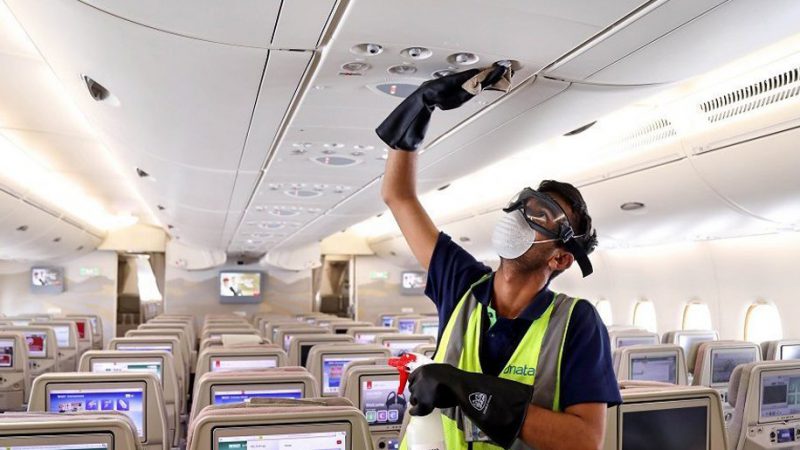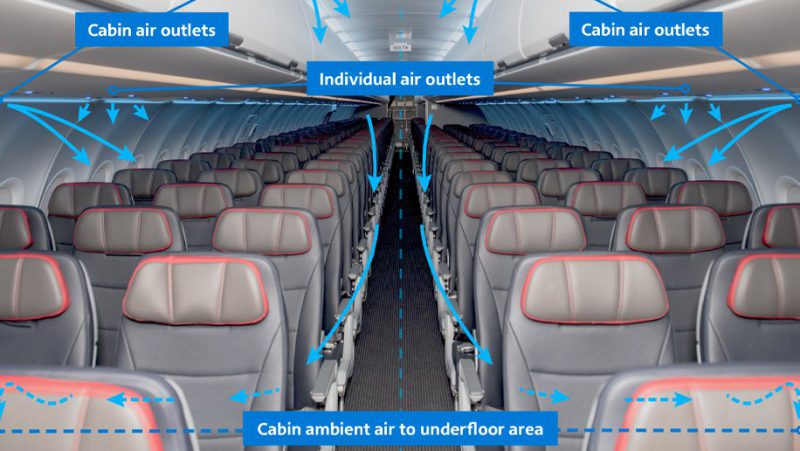How Safe is the Air Aboard Airliners?
Technology, both new and old, is available to help air travelers breathe a little easier when booking their next trip
July 6, 2020


Making flying safe and clean for passengers is the holy grail of air travel these days. And although there are plenty of new practices afloat, airlines are all over the map when it comes to what’s new, what’s working and what will make passengers confident about taking to the air.
Topping the list of safety concerns is the air itself. Breathing is now a contact sport with all sorts of consequences built in. Are airliners safe to sit in for five or six hours at a clip, often packed like fruit heading for market? Are masks still necessary to wear onboard? What if the person behind you has a fever just a smidge below the allowable degree? What if the person in the middle seat starts coughing? Should you touch the seatback button or use the tray table?
Airlines are claiming that flying has never been cleaner or safer and in many ways they are right. But then we have never had a virus like the novel coronavirus.
In an effort to quell fears and answer those questions that can be answered, Boeing’s product marketing director, Jim Haas, recently spoke to the fact that the air circulation inside a typical aircraft is, indeed, clean and has been that way since the mid-1990s when HEPA filters were introduced. The filters are medical grade, often used in hospital isolation chambers and operating rooms to scrub the tiniest particles – including viruses – from the air with 99.9 percent effectiveness.
But it is not just the air moving through the filter, it is also the air in its flow path that makes flying into a reasonable risk to take.
“A key point that many passengers do not understand is the direction the air flows,” said Haas. “Many think the air flows from front to back. It does not. It comes in from the top, comes down onto the seat and exits out, and there is continuous ventilation in the cabin. Cabin air is exchanged every two to three minutes, which is much faster than office buildings and other interior spaces where people go. We designed it specifically to do this. And it is one of key points we want people to understand.”

Aircraft makers, including Boeing, Airbus and Embraer, are working together and sharing notes on what is working and what is not to optimize the air quality inflight. Haas notes that this part of the business is not a competition. There is too much at stake.
But he also notes that the systems have been in place for some 25 years so it is not the technology that is new when it comes to air filtration. What is new is the disinfecting practices ahead of boarding coupled with the temperature monitoring of passengers at the gate.
To that end, airlines are looking at disinfecting practices and devices that could be instrumental in killing bacteria and viruses from all surfaces passengers touch giving each passengers a completely sanitized environment on takeoff.
Among those approaches are the use of sanitizing chemicals, including Purell-like liquids proven to be safe for humans, non-toxic or and not harmful to furnishings and equipment and completely deadly to viruses, bacteria and fungi. Periodic spraying of anti-microbial coating is also necessary to create a hostile environment for lingering germs that may not die so quickly. In addition, new ways of dispatching ultra violet rays have been deployed to destroy lingering unseen enemies on textiles and other surfaces. Boeing has been beta-testing a portable wand that evenly radiates the deadly UV rays on a front to back sweep of the empty aircraft before passengers board. A built-in UV solution for disinfecting bathroom areas is now in the prototype stage as well, but because that involves a structural change for inflight use, regulatory approvals are necessary and, likely, years away.
“We are working with a variety of industries, such as IATA, and other airline manufacturers, the ICCAIA (International Coordinating Council of Aerospace Industries Associations) and we are working with airports – what happens at the airport is one of the first layers of travel. It is important for travelers to have a consistent experience country to country. We are also working with researchers and academia to check our modeling and make sure the way we understand the virus lines up with what everyone else understands,” said Haas.
“We see the necessity of having a multilayered approach to protect the passenger during the entire journey: From home to airport to departure to the cleaning and disinfecting and all the tech in place — and then there is the cabin experience inflight. Air cleaning and filtration, arrangements of seats and role of face masks – all put together – makes flying safe.”
While each airline must adopt its own policies, airline manufacturers like Boeing and Airbus do much of the heavy lifting to make sure the craft interior has all the structural advantages required for flying safely during COVID-19 times and that the manufacturers’ airline customers have the research and tested recommendations by which to model their policies.
For instance, Singapore Airlines is assuring that all lavatories feature contactless faucets and have anti-bacterial hand wash. SIA is also looking at a trial of an ultra-violet light cleaning procedure on the ground for its lavatories before every flight. To give passengers added reassurance, the airline now provides all passengers with a Care Kit that includes a surgical mask, anti-bacterial hand wipes and hand sanitizer.
As for seat distancing as a prophylactic against exposure, some airlines are pledging to uphold middle seat vacancies while others are not, suggesting such a financially crippling move for an airline is more a public relations consideration than a proven protection against contracting the virus.
American Airlines, Air Canada and United have eschewed the practice while other airlines, such as Delta,Southwest and JetBlue have committed to block all or some seats for social distancing assurances, at least for a time. Sen. Bernie Sanders and federal health officials criticized American Airlines recently for altering policy toward booking flights to capacity.
Currently, there are no federal requirements to distance travelers on commercial aircraft. Nor is there a federal mandate guiding the wearing of masks inflight. Last week, the Departments of Homeland Security, Transportation, and Health and Human Services jointly issued guideline recommendations for the air travel industry in a document called the “Runway to Recovery.” Policies and the enforcement of those policies, however, remain entirely in the hands of each airline.




